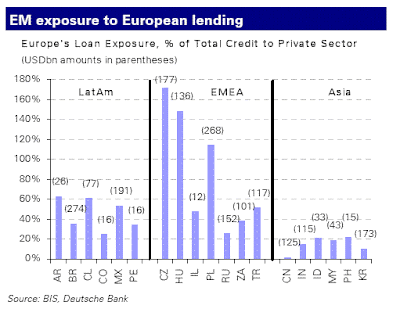Safe Haven in Emerging Markets? Standard Chartered notes today:
If the crisis escalates, Asia could be affected via several channels: reduced bank lending from Europe (as of end-2009, continental European banks accounted for 25%, or USD 434bn, of total BIS bank lending to emerging Asia), a collapse in trade flows (Europe represents a marginally larger slice of Asia’s trade than the US, with China, Hong Kong, Korea, Malaysia and Singapore the most vulnerable), and through potential asset price inflation in Asia, with Europe’s low-interest-rate environment feeding capital flows into Asia.Some countries in emerging countries have also large fiscal deficits and reliance on government debt. Click on chart to enlarge, courtesy of Standard Chartered.
 Economists at Deutsche Bank were pointing to EMEA and LatAm yesterday, as the most vulnerable regions depending on European lending:
Economists at Deutsche Bank were pointing to EMEA and LatAm yesterday, as the most vulnerable regions depending on European lending:According to BIS data as of December 2009, the total loan exposure of EMEA countries to European banks was the largest at USD963bn, followed by LatAm with USD600bn and Asia with USD505bn. The differences, however, are more striking when the exposure is measured as a percentage of GDP. In EMEA, the figure is equivalent to 47%, in LatAm is 19% and in Asia is only 7%. Finally, loan exposure to Europe as a percentage of bank credit to the private sector is also the highest in EMEA at 58%, followed by LatAm at 42% and Asia at 5%. It is worth noting that the BIS figures reflect consolidated foreign claims vis-à-vis individual countries by nationality of reporting banks, thus possibly differing from some of the data provided by each individual central bank when reporting domestic and foreign debt.
Click on chart to enlarge, courtesy of Deutsche Bank.

No comments:
Post a Comment